Between Logical Components and Functions
When new logical components are introduced, implement links to function or requirement can be created to capture the
reason why these components are added to the definition of the product.
In this task we will make an implement relation between objects
in the Functional and Logical trees in RFLP
structure.
Select a logical component in the Logical
tree and click Create
an Implement Relation
 . .
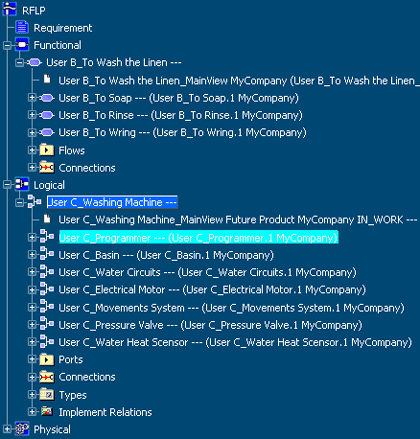
The Create
an Implement Relation is highlighted. You can now select the
function (function reference, function port, function connection) you want the logical component to be linked
to. In the
Functional category structure, select a function you want the logical component to be linked to.
The Implement Relation dialog box appears.
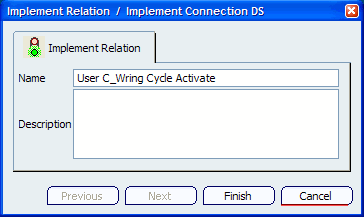
Type the name and description for the implement
relation and click Finish.
The implement relations have been created between the selected
objects. The 2D representation of the logical component has an
icon displayed, indicating that implement relation exists between
logical component and a function.

Note: If implement relation is incomplete (one of the entity pointed
by the relation is not loaded in session or has been deleted), the following is
displayed in the Logical tree:

By default, incomplete implement relations are not visible.
Select the Tools > Options > Infrastructure > VPM
Functional Logical Editor >
General tab to access options for Implement Relations
Folders. Click the Display Incomplete Implement Relation Folder in tree
check box to enable/disable the display of the incomplete
implement relation folder in tree. Refer to the customization section
for more information on settings for VPM Functional Logical
Editor.
- Click the icon in the 2D
representation to see the list of implemented/implementing
object to display.
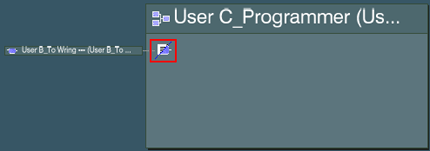
- Click on an entry in the list to
display the main view the object (only if it is a function or a
logical component)

- Right-click the selected the 2D
representation to see and use the contextual menu commands.
To save the changes, select PLM Access >
Propagate....
The Save Management dialog box displaying a list of
objects to be saved appears. Click OK to save.

Between Logical and Physical
Components
You can create implement relations for physical
components.
When the new physical components are
introduced, the implement links to logical component must be
created to capture the fact that a given physical component
implements the logical component of the product.
In this task we will make an implement relation between
components of the Logical and
Physical trees in RFLP structure.
Select a logical component in the Logical
tree and click Create
an Implement Relation
 . .
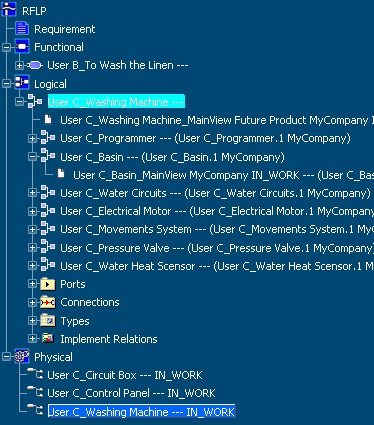
The Create
an Implement Relation is highlighted. You can now select the
physical component you want the logical component to be linked
to. In the
Physical category structure, select a physical
component you want the logical component to be linked to.
The Implement Relation dialog box appears.

Type the name and description for the implement
relation and click Finish.
The implement relations have been created between the selected
components. The 2D representation of the logical component has an
icon displayed, indicating that implement relation exists between
logical and physical components.
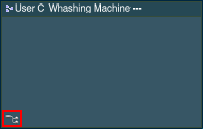
In the Physical category structure
of the RFLP tree, like for the Functional and
Logical categories, the created Implement Relation
is displayed under the root of the tree structure of the selected physical component.
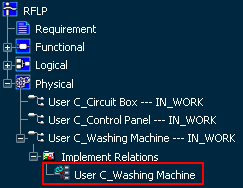
Use the Edit Implement Relations
 command to view the list of objects implemented by a physical
component.
command to view the list of objects implemented by a physical
component.
- Click the icon in the 2D
representation to see the list of implemented/implementing
object to display.
- Right-click the selected the 2D
representation to see and use the contextual menu commands.
To save the changes, select PLM Access >
Propagate....
The Save Management dialog box displaying a list of
objects to be saved appears. Click OK to save.

Between a Requirement and a Flow
When a new flow is introduced to answer a specific requirement, an implement relation can be created between them to capture this link.
In this task we create an implement relation between a requirement and a flow in the RFLP
structure.
You must have created:
- A requirement structure containing a requirement.
- A functional structure with ports and associated flows.
Select a requirement in the Requirement
tree and click Create
an Implement Relation
 or right-click the requirement and select Create Implement Relation in the contextual menu. or right-click the requirement and select Create Implement Relation in the contextual menu. You can now select the
flow you want the requirement to be linked
to. Expand the
Flows node in the tree.
Select the flow in the tree (make sure that you select the flow that can be seen below the port node in the tree) and not the port. The Implement Relation dialog box is displayed. Type the name and description (optional) for the implement
relation and click Finish.
The implement relation has been created between the selected
components. The  icon indicates that the implement relation exists between
the requirement and the flow. icon indicates that the implement relation exists between
the requirement and the flow.

Note:
- The Edit Implement Relation command is available on Flows to see and edit the implement relation related to these objects.
- The Implement relations can be displayed in the Shading category of the PLM Compass East Quadrant when selecting the entities in the tree.

Between a Requirement and a System Type
When a new system type is introduced to answer a specific requirement, an implement relation can be created to capture this link.
In this task we create an implement relation between a requirement and a system type in the RFLP
structure.
You must have created:
- a requirement structure containing a requirement.
- a logical structure with ports with associated system types.
Select a requirement in the Requirement
tree and click Create
an Implement Relation
 or right-click the requirement and select Create Implement Relation in the contextual menu. or right-click the requirement and select Create Implement Relation in the contextual menu. You can now select the
system type you want the requirement to be linked
to. Expand the
Types node in the tree.
Select the Target type. The Implement Relation dialog box is displayed. Type the name and description for the implement
relation and click Finish.
The implement relation has been created between the selected
components.
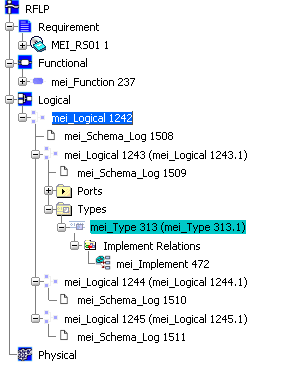
Note:
- The Edit Implement Relation command is available on types to see and edit the implement relation related to these objects.

- The Implement relations can be seen in the Shading category of the PLM Compass East Quadrant when selecting the entities in the tree.

Between Flow and System Type
When a new system type is introduced to answer a specific flow, an implement relation can be created to capture this link.
In this task we create an implement relation between a flow and a system type in the RFLP
structure.
You must have created:
- a functional structure containing a flow.
- a logical structure with ports with associated systems types.
Select the
system type you want the flow to be linked
to and click Create an Implement Relation  or right-click the requirement and select Create Implement Relation in the contextual menu. or right-click the requirement and select Create Implement Relation in the contextual menu. Expand the
Flow node in the tree and select the target flow.
The Implement Relation dialog box appears. Type the name and description for the implement
relation and click Finish.
The implement relation has been created between the selected
components. Note:
- The Edit Implement Relation command is available on Flows to see and edit the implement relation related to these objects.
- The Implement relations can be seen in the Shading category of the PLM Compass East Quadrant when selecting the entities in the tree.
|
![]()
![]()
![]()
![]()










 icon indicates that the implement relation exists between
the requirement and the flow.
icon indicates that the implement relation exists between
the requirement and the flow.

